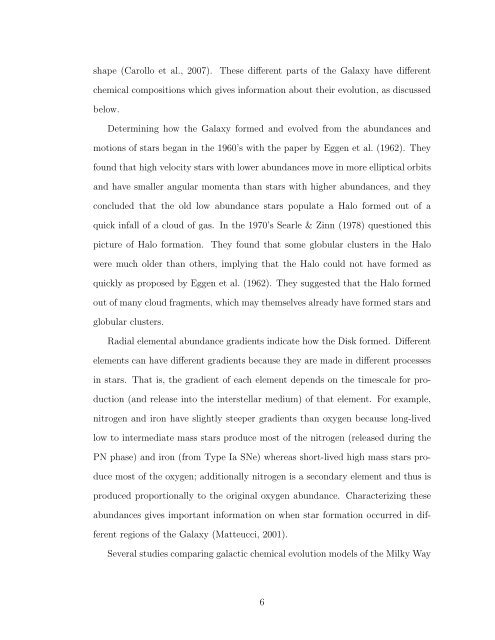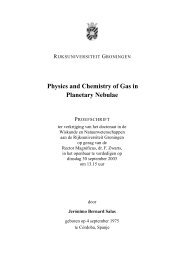TRACING ABUNDANCES IN GALAXIES WITH THE SPITZER ...
TRACING ABUNDANCES IN GALAXIES WITH THE SPITZER ...
TRACING ABUNDANCES IN GALAXIES WITH THE SPITZER ...
You also want an ePaper? Increase the reach of your titles
YUMPU automatically turns print PDFs into web optimized ePapers that Google loves.
shape (Carollo et al., 2007). These different parts of the Galaxy have different<br />
chemical compositions which gives information about their evolution, as discussed<br />
below.<br />
Determining how the Galaxy formed and evolved from the abundances and<br />
motions of stars began in the 1960’s with the paper by Eggen et al. (1962). They<br />
found that high velocity stars with lower abundances move in more elliptical orbits<br />
and have smaller angular momenta than stars with higher abundances, and they<br />
concluded that the old low abundance stars populate a Halo formed out of a<br />
quick infall of a cloud of gas. In the 1970’s Searle & Zinn (1978) questioned this<br />
picture of Halo formation. They found that some globular clusters in the Halo<br />
were much older than others, implying that the Halo could not have formed as<br />
quickly as proposed by Eggen et al. (1962). They suggested that the Halo formed<br />
out of many cloud fragments, which may themselves already have formed stars and<br />
globular clusters.<br />
Radial elemental abundance gradients indicate how the Disk formed. Different<br />
elements can have different gradients because they are made in different processes<br />
in stars. That is, the gradient of each element depends on the timescale for pro-<br />
duction (and release into the interstellar medium) of that element. For example,<br />
nitrogen and iron have slightly steeper gradients than oxygen because long-lived<br />
low to intermediate mass stars produce most of the nitrogen (released during the<br />
PN phase) and iron (from Type Ia SNe) whereas short-lived high mass stars pro-<br />
duce most of the oxygen; additionally nitrogen is a secondary element and thus is<br />
produced proportionally to the original oxygen abundance. Characterizing these<br />
abundances gives important information on when star formation occurred in dif-<br />
ferent regions of the Galaxy (Matteucci, 2001).<br />
Several studies comparing galactic chemical evolution models of the Milky Way<br />
6













